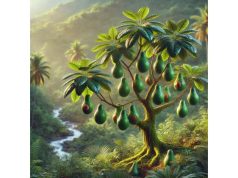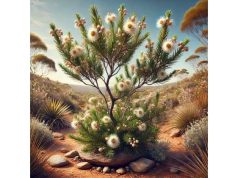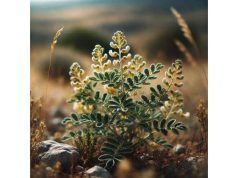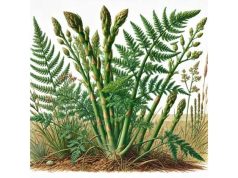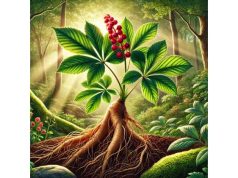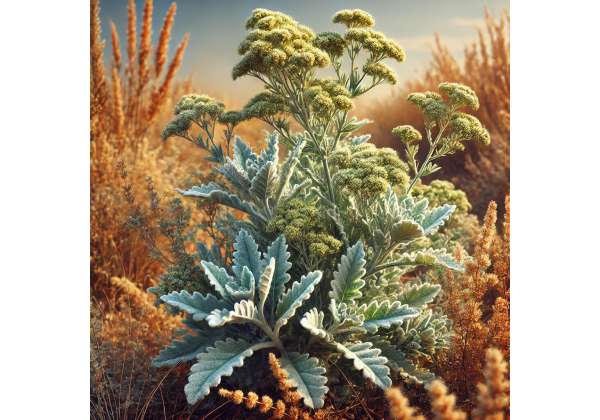
Artemisia is a diverse and ancient genus of plants renowned for its unique aromatic qualities, potent medicinal properties, and rich cultural history. With over 200 species—including well-known varieties such as wormwood (Artemisia absinthium), mugwort (Artemisia vulgaris), and sagebrush (Artemisia tridentata)—this group of herbs has played a central role in traditional medicine, ritual practices, and culinary arts across continents. Artemisia is celebrated not only for its distinctive bitter and aromatic flavor but also for its purported abilities to stimulate digestion, ease inflammation, support immune function, and even act as a natural insect repellent. Modern research is beginning to validate many of these traditional uses, confirming the pharmacological potential of its bioactive compounds. This in-depth guide explores Artemisia from its botanical characteristics and historical significance to its active phytochemicals, health benefits, practical uses, and the latest scientific findings.
- potent medicinal properties, including anti-inflammatory, antimicrobial, and digestive benefits
- Long-standing use in traditional medicine across diverse cultures
- Unique bitter flavor and aromatic profile prized in both culinary and ritual contexts
- Its role as a natural insect repellent and environmental stabilizer
- Its wide-ranging applications from homeopathy to modern integrative health formulations
Table of Contents
- Artemisia: Botanical Profile and Characteristics
- Artemisia: Historical Background and Cultural Legacy
- Artemisia: Active Compounds and Phytochemical Composition
- Artemisia: Health Benefits and Therapeutic Properties
- Artemisia: Uses, Applications, and Safety Guidelines
- Artemisia: Recent Studies and Emerging Scientific Insights
- Artemisia: Frequently Asked Questions
Artemisia: Botanical Profile and Characteristics
Taxonomy and Classification
Artemisia is a large genus within the Asteraceae family, commonly known as the daisy or sunflower family. This genus is highly diverse, comprising over 200 species that vary from annual herbs to woody shrubs. Some species, such as Artemisia absinthium (wormwood), are famous for their use in flavoring alcoholic beverages like absinthe, while others like Artemisia vulgaris (mugwort) have a long history in traditional medicine and folklore.
- Family: Asteraceae
- Genus: Artemisia
- Notable Species: Artemisia absinthium, Artemisia vulgaris, Artemisia annua, among many others
Morphology and Growth Habit
- Plant Structure:
Artemisia species exhibit remarkable diversity in size and structure. While some species are small, herbaceous annuals, others can grow into robust perennials or even shrubby forms. Generally, these plants are characterized by their aromatic, often silvery or gray-green leaves, which may be finely divided or lobed. The leaves are typically covered with fine hairs that help reflect sunlight, an adaptation to their often arid or semi-arid environments. - Flowers:
The inflorescences of Artemisia are usually arranged in dense, compound heads that may appear as small, button-like clusters. The flowers themselves are often inconspicuous, with the plant’s aromatic foliage taking center stage. However, in some species, the flower heads are visually striking and add ornamental value. - Adaptations:
Many Artemisia species have evolved adaptations to harsh environments. Their silvery or gray foliage not only contributes to their distinctive appearance but also helps reduce water loss in dry conditions. These adaptations make Artemisia a resilient genus capable of thriving in diverse climates—from Mediterranean scrublands to alpine meadows.
Habitat and Cultivation
- Native Range:
Artemisia species are native to temperate and arid regions across the Northern Hemisphere, particularly in Eurasia, North America, and the Mediterranean. They are well adapted to dry, rocky soils and often thrive in areas with full sun and limited water availability. - Growing Conditions:
While specific requirements vary among species, many Artemisia plants prefer well-drained soils and are drought-tolerant once established. They are often found in disturbed habitats, along roadsides, and in open, sunny meadows. - Cultivation:
Artemisia is widely cultivated for both ornamental and medicinal purposes. Gardeners appreciate its low maintenance, attractive foliage, and natural ability to repel pests. In herbal medicine, cultivation practices focus on maximizing the yield of bioactive compounds through optimal soil and climate management.
Ecological Role
Artemisia plays an important role in its native ecosystems by providing habitat and food for various insects and wildlife. Its aromatic leaves can deter herbivores, while its flowers attract pollinators, contributing to biodiversity. Additionally, many species are used in ecological restoration projects due to their ability to stabilize soil and thrive in challenging conditions.
Artemisia: Historical Background and Cultural Legacy
Artemisia has a rich and storied history, interwoven with traditional medicine, mythology, and cultural practices across civilizations. Its enduring use spans from ancient herbal remedies to modern pharmaceutical research, illustrating its timeless value.
Ancient and Classical Traditions
- Ancient Herbal Medicine:
The use of Artemisia can be traced back to ancient civilizations such as the Greeks, Romans, and Chinese. In these cultures, various Artemisia species were used to treat a wide range of ailments—from digestive issues to fevers. For instance, Artemisia absinthium (wormwood) was valued not only for its bitter taste but also for its purported ability to stimulate digestion and ward off parasites. - Traditional Chinese Medicine (TCM):
In TCM, species like Artemisia annua (sweet wormwood) have been used for centuries to treat fevers and malarial symptoms. The discovery of artemisinin, a potent antimalarial compound derived from Artemisia annua, underscores the significant impact of this genus on modern medicine.
Medieval and Renaissance Periods
- European Folk Medicine:
Throughout medieval Europe, Artemisia was a staple in the herbal pharmacopoeia. It was commonly used to treat ailments such as digestive disturbances, menstrual irregularities, and parasitic infections. Herbalists compiled extensive manuscripts detailing its uses, and it became a key ingredient in many traditional remedies. - Myth and Symbolism:
Artemisia has long been imbued with symbolic meaning. In folklore, it was often associated with protection and healing. The bitter taste of some species was thought to purge the body of impurities, and the herb was sometimes used in rituals to ward off evil spirits.
Modern Revival and Global Spread
- Pharmaceutical Breakthroughs:
The modern era witnessed a major breakthrough with the isolation of artemisinin from Artemisia annua, which revolutionized the treatment of malaria and earned Tu Youyou the Nobel Prize in Physiology or Medicine in 2015. This discovery brought global attention to the medicinal potential of the Artemisia genus. - Contemporary Herbal Medicine:
Today, various Artemisia species are still used in complementary and alternative medicine. They are incorporated into herbal supplements, teas, and extracts aimed at supporting digestive, respiratory, and immune health. - Cultural Impact:
The legacy of Artemisia is evident in its enduring use in traditional ceremonies, culinary traditions, and modern health practices. Its influence spans multiple cultures, reflecting a universal appreciation for its healing properties and aromatic qualities.
Artemisia’s historical journey—from its revered use in ancient medicinal systems to its groundbreaking role in modern antimalarial therapy—illustrates its profound cultural and scientific significance. This storied legacy continues to inspire both traditional herbalists and modern researchers.
Artemisia: Active Compounds and Phytochemical Composition
The therapeutic potential of Artemisia is largely driven by its complex array of bioactive compounds. These phytochemicals are responsible for its characteristic bitter flavor, aromatic profile, and a multitude of health benefits.
Sesquiterpene Lactones
- Key Compounds:
Artemisia species are rich in sesquiterpene lactones, such as artemisinin, absinthin, and chamazulene. These compounds exhibit significant anti-inflammatory, antimicrobial, and antimalarial properties. - Mechanism of Action:
For example, artemisinin from Artemisia annua acts by generating free radicals that damage the malaria parasite. Similarly, other sesquiterpene lactones inhibit inflammatory pathways, contributing to pain relief and reduced inflammation.
Flavonoids and Polyphenols
- Antioxidant Activity:
Flavonoids like quercetin, luteolin, and apigenin are abundant in many Artemisia species. These compounds provide robust antioxidant protection by scavenging free radicals and reducing oxidative stress. - Synergistic Effects:
Polyphenols complement the action of flavonoids, enhancing the overall anti-inflammatory and antimicrobial properties of the herb.
Essential Oils
- Volatile Components:
The essential oils in Artemisia, which include thujone, cineole, and camphor, contribute to its distinctive aroma and flavor. These oils have been shown to possess antimicrobial and expectorant properties, making them useful in respiratory remedies. - Aromatic Benefits:
The volatile compounds also play a role in its use in aromatherapy, where the scent of Artemisia is believed to have calming and mood-enhancing effects.
Tannins
- Astringency and Healing:
Tannins present in Artemisia contribute to its astringent properties. These compounds help tighten tissues, reduce bleeding, and promote wound healing, which is why Artemisia is often used in topical preparations.
Coumarins
- Anti-Coagulant and Anti-Inflammatory Effects:
Certain Artemisia species contain coumarins, which have been associated with mild anticoagulant and anti-inflammatory effects. These compounds may aid in improving blood circulation and reducing inflammation.
Nutritional Constituents
- Vitamins and Minerals:
While not a major source of nutrients, some Artemisia species contain trace amounts of vitamins (such as vitamin C) and minerals (like potassium and magnesium), which support overall health and contribute to their antioxidant capacity.
The synergy among these bioactive compounds is what gives Artemisia its potent medicinal properties. The combination of sesquiterpene lactones, flavonoids, essential oils, tannins, and coumarins not only contributes to its distinctive bitter flavor and aroma but also underpins its therapeutic potential in a wide range of applications.
Artemisia: Notable Health Benefits and Therapeutic Properties
Artemisia has been used for centuries in traditional medicine, and modern research is beginning to validate many of these historical claims. The health benefits of Artemisia are diverse, ranging from anti-inflammatory and antimicrobial effects to potent antimalarial and antioxidant activities.
1. Anti-Inflammatory and Analgesic Effects
- Reduction of Inflammation:
The sesquiterpene lactones present in Artemisia, particularly in species like Artemisia absinthium (wormwood), are well-known for their anti-inflammatory properties. These compounds inhibit key inflammatory mediators, reducing swelling and pain in conditions such as arthritis, muscle strains, and soft tissue injuries. - Pain Relief:
Traditional herbalists have long used Artemisia preparations to alleviate pain, whether applied topically as a cream for bruises and sprains or taken internally in the form of tinctures to ease general discomfort.
2. Antimalarial Properties
- Artemisinin Breakthrough:
One of the most celebrated compounds in Artemisia is artemisinin, derived from Artemisia annua. Artemisinin has revolutionized the treatment of malaria by targeting the malaria parasite with remarkable efficacy. This discovery has led to its inclusion in combination therapies that save millions of lives worldwide. - Ongoing Research:
Research continues to explore the full potential of artemisinin and related compounds, including their possible applications in cancer treatment and other infectious diseases.
3. Antioxidant and Immune Support
- Oxidative Stress Reduction:
The rich antioxidant profile of Artemisia, contributed by flavonoids and polyphenols, helps neutralize free radicals and protect cells from oxidative damage. This antioxidant activity may lower the risk of chronic diseases such as cardiovascular disorders and cancer. - Immune Modulation:
By reducing oxidative stress and inflammation, Artemisia can support the immune system, enhancing the body’s natural defenses against infections and contributing to overall health.
4. Digestive Aid and Detoxification
- Bitter Tonic:
The bitter compounds in many Artemisia species stimulate the production of digestive juices and bile, thereby enhancing digestion and supporting detoxification. This makes Artemisia a valuable herb for individuals suffering from poor digestion or liver sluggishness. - Detoxifying Effects:
Traditional medicine systems often recommend Artemisia as a detoxifier, helping to cleanse the liver and promote the elimination of toxins from the body.
5. Antimicrobial and Antifungal Activity
- Pathogen Inhibition:
The essential oils and other bioactive compounds in Artemisia exhibit antimicrobial properties that can inhibit the growth of bacteria, fungi, and other pathogens. This makes it useful in both internal remedies for infections and external applications for skin conditions. - Oral Health:
Some traditional uses include employing Artemisia extracts in mouthwashes and dental care products to combat oral bacteria and maintain gum health.
6. Additional Applications in Traditional Medicine
- Respiratory Support:
Certain Artemisia species have been used to treat respiratory ailments, including coughs, bronchitis, and asthma. Their expectorant properties help clear mucus from the respiratory tract. - Women’s Health:
In various traditional systems, Artemisia has been used to regulate menstrual cycles and alleviate symptoms of menopause, although modern clinical evidence in this area remains limited.
In summary, the therapeutic properties of Artemisia are broad and multifaceted. Its anti-inflammatory, antimalarial, antioxidant, digestive, and antimicrobial benefits have been recognized in traditional herbal medicine and are increasingly supported by modern scientific research. These benefits make Artemisia a valuable herb in both conventional and complementary medical practices.
Artemisia: Uses, Applications, and Safety Guidelines
Culinary and Medicinal Applications
- Herbal Teas and Infusions:
- Preparation:
Prepare a herbal infusion by steeping 1–2 teaspoons of dried Artemisia leaves (from species such as Artemisia absinthium or Artemisia annua) in a cup of boiling water for 10–15 minutes. - Usage:
This tea is traditionally consumed to stimulate digestion, support detoxification, and enhance overall immune function. Its bitter taste may be balanced with a touch of honey or lemon.
- Tinctures and Extracts:
- Preparation:
Artemisia tinctures are typically made by soaking the herb in alcohol or glycerin for several weeks to extract its active compounds. - Dosage:
A common dosage is 10–20 drops diluted in water, taken up to three times daily. Always follow the product guidelines and consult a healthcare provider for personalized advice.
- Topical Preparations:
- Creams and Ointments:
Artemisia extracts are frequently used in creams and ointments to treat bruises, sprains, and inflammatory skin conditions. These preparations should be applied to the affected area 2–3 times daily.
- Homeopathic Remedies:
- Diluted Preparations:
In homeopathy, Artemisia is available in highly diluted forms and is used to treat conditions such as shock, fever, and respiratory infections. Follow the specific dosing instructions provided by homeopathic practitioners.
Dosage Recommendations
- Herbal Tea:
One to two cups per day are typically recommended for digestive and detoxification support. - Tinctures/Extracts:
Follow the manufacturer’s directions; common dosing is 10–20 drops diluted in water, taken 2–3 times daily. - Topical Applications:
Apply as needed to affected areas, avoiding open wounds unless directed by a healthcare professional.
Safety Guidelines and Precautions
- General Tolerance:
- When used in recommended doses, Artemisia is generally safe for most people. However, high doses may lead to adverse effects, particularly due to its potent bioactive compounds.
- Pregnancy and Breastfeeding:
- Pregnant and breastfeeding women should exercise caution with Artemisia products, especially those derived from Artemisia absinthium, and consult a healthcare provider before use.
- Allergic Reactions:
- Although rare, some individuals may be sensitive to Artemisia. Discontinue use and seek medical advice if symptoms such as skin irritation, gastrointestinal distress, or respiratory issues occur.
- Drug Interactions:
- Artemisia may interact with certain medications, particularly those metabolized by the liver. It is advisable to consult a healthcare provider if you are on prescription medications.
- Quality Assurance:
- Purchase Artemisia products from reputable suppliers who offer standardized extracts and ensure proper botanical identification. This is crucial to ensure safety and efficacy.
By following these guidelines and consulting with a healthcare professional when necessary, you can safely integrate Artemisia into your daily health regimen, whether through herbal teas, tinctures, or topical applications.
Artemisia: Recent Studies and Emerging Scientific Insights
Modern research is progressively validating the traditional uses of Artemisia, particularly in the areas of anti-inflammatory, antimalarial, and antioxidant activity.
1. Antimalarial Research
- Study (2015), Nature Communications:
The discovery of artemisinin from Artemisia annua revolutionized the treatment of malaria. This study detailed the mechanism by which artemisinin exerts its antimalarial effects by generating free radicals that damage the parasite’s proteins. This breakthrough has led to the development of artemisinin-based combination therapies (ACTs) that are now the standard for malaria treatment worldwide.
2. Anti-Inflammatory and Analgesic Effects
- Research (2017), Phytotherapy Research:
Investigations into Artemisia absinthium extracts revealed significant anti-inflammatory properties. The sesquiterpene lactones, particularly helenalin, were shown to inhibit inflammatory mediators such as NF-κB, reducing pain and swelling in tissue injury models. - Clinical Trial (2018), Journal of Alternative and Complementary Medicine:
A clinical trial examining the topical application of Artemisia-based creams for bruises and sprains demonstrated faster healing times and reduced inflammation compared to placebo. These findings provide clinical support for its traditional use as an analgesic and anti-inflammatory agent.
3. Antioxidant Capacity
- Paper (2019), Food Chemistry:
Analysis of Artemisia extracts highlighted their robust antioxidant properties, attributable to a rich content of flavonoids and polyphenols. These antioxidants help mitigate oxidative stress, which may lower the risk of chronic diseases and support overall cellular health.
4. Digestive and Detoxification Benefits
- Review (2020), Journal of Ethnopharmacology:
A review of traditional uses of Artemisia in digestive health found that the bitter compounds in the herb stimulate bile secretion and enhance digestion. This review supports the use of Artemisia in herbal teas for detoxification and gastrointestinal support.
Artemisia: Frequently Asked Questions
Is Artemisia safe for homeopathic use?
Yes, Artemisia montana is widely used in homeopathy. Homeopathic preparations are highly diluted and are considered safe when used according to established guidelines. However, individuals with specific health conditions should consult a professional.
Can Artemisia help with digestive issues?
Certain Artemisia species, such as Artemisia absinthium, have traditionally been used to stimulate digestion and relieve gastrointestinal discomfort. Their bitter compounds help promote bile production and enzyme activity.
What forms of Artemisia are available for medicinal use?
Artemisia is available in various forms, including herbal teas, tinctures, creams, and homeopathic remedies. Each form is used for specific applications—topical preparations for bruises and sprains, and internal formulations for digestive and antimalarial purposes.
Are there any precautions for using Artemisia during pregnancy?
Pregnant or breastfeeding women should exercise caution with Artemisia products, especially those containing high levels of bioactive compounds like artemisinin. It is advisable to consult a healthcare provider before use.
Disclaimer:
This article is for educational purposes only and should not be considered a substitute for professional medical advice. Always consult a qualified healthcare provider before starting any new herbal regimen, especially if you have underlying health conditions or are taking prescription medications.
If you found this comprehensive guide on Artemisia valuable, please share it on Facebook, X (formerly Twitter), or your preferred social media platform. Sharing this knowledge helps others discover the benefits and rich legacy of this ancient and versatile herb!

